
One of the side effects of renovating an old house, I’ve found, is the way my brain has come to toggle between the absurd optimism I feel before a project begins and the extreme despair I experience when my ideas about how things will be collide with the reality of how things actually are. Everything is more or less microcosmic of this entire renovation endeavor: “These 150 year-old rotted box gutters—I bet I can just fix them myself in a weekend!” and “This kitchen”¦it just needs a couple coats of paint!” are just miniature versions of “this house”¦there’s not that much wrong with it! We’re terrific!”
False. Everything is hard and it takes forever and there are no such things as happy surprises we’re not that terrific. The end.
I had this big idea when we tore down the acoustic tiles on the dining room ceiling that the original plaster ceiling above it would be in pretty great, totally fixable condition. Why did I think this? Probably TV. Mostly delusion. It’s easy for me to blame things on TV on account of how many years I’ve been watching it, but mostly I’m just really pretty dumb.
The ceiling was not OK. It had to come down. It took us like 3 days and and tons of labor and clogged pores and 50 contractor bags and 3 tons of garbage and a truly awe-inspiring amount of dust to get rid of it. Romantic times with my fiancé I’ll cherish always.
Then, because I despise and actively ward off emotions such as happiness or peace or joy, I had this fun idea: now that one of the acoustic tile ceilings is down and has to be drywalled, why not see what’s lurking under the other acoustic tile ceiling, in the room right next door?
I know that the responsible part of my brain did this for good reason: if I’m having a ceiling professionally drywalled, it’s going to be less money and less chaos in the long run if I just have them both done at the same time. But the delusional side of my brain, the kicky one that informs between 99-100% of my daily actions, did it because I really thought the other ceiling would be in pretty great, totally fixable condition, which would be a huge morale boost and exciting pick-me-up.
Why? Because. Because contrary to all evidence like maybe just having done this a week earlier, I convinced myself that the house was totally going to cut us a break on this one. It couldn’t possibly be like the other one, because science and pipes and karma and things. Right?

These ceiling tiles were made of a different material than the other ceiling tiles (don’t worry, I knew this beforehand and they were each tested separately for asbestos). The dining room had individual tiles, but these were actually more like large, embossed panels made to look like individual tiles. Let that sink in. Somebody actually WANTED it to look like they put up an acoustic tile ceiling, but they didn’t. That was the actual aspiration with this.
So that was the first thing I noticed. The second thing I noticed was how removing the panels also brought a shower of dried mouse poop raining down on my head like glitter at a Mariah Carey concert. So much mouse poop. We don’t have mice, and I’ve never seen or heard a mouse, but apparently that was not always the case. There used to be a mouse, and it used to poop all the time, and now that poop was in my hair.
The third thing I noticed was that this ceiling was obviously erected by some kind of evil genius lunatic. LOOK AT THAT FRAMING. Could they have just nailed furring strips to the joists like in the dining room? Absolutely not. Instead, they definitely needed an intricate series of interlocking, multi-layer framing using a combination of furring strips and old lath and probably at least 400,000 nails. Why. Why was it like this. Why would someone do this.
The fourth thing I noticed was that the plaster ceiling? Actually looked pretty great! My earlier wager that it would be pretty great was right on the money. I felt really smart for arbitrarily deciding this earlier on, and very validated that I really listened to my gut on that one. Thanks, gut!

Moving down the room toward the front of the house, though, I noticed that the plaster seemed like it was getting a little iffy. The cracks were bigger and there were parts where the multi-layer furring catastrophe was nailed directly through sagging plaster and up into a joist, causing even larger holes and voids. By the time I got to the corner, I was frantically putting up plaster buttons to keep huge sections from falling. I decided this was probably/definitely the worst of it, so I was going to continue being careful and cautious and trying to save what was there.
Removing acoustic tiles from a plaster ceiling is basically like opening a present. You never know what you’ll find, but usually it ends up being death and plague and hardship.

Aaaaaaaaand, yeah. By the time we made it three quarters of the way around the room, it was patently clear that this ceiling was even worse than the other one, which is really saying something. There’s just really no way that I know of to fix something this far gone and have it look even a little bit good.
At this point, the ceiling just sat like this for a week or so, festering. We had a couple of houseguests, and Max made the grown-up decision that it wasn’t OK to put them through living in a house where plaster ceilings were being actively removed. Ever the hostess.
Then the houseguests left. Then Max had to go back to Brooklyn. Then I was alone in the house. Ohhhhhhh shit.

I don’t really have any process photos of removing the crazy intricate wood framing, partially because I was alone and it was the middle of the night and I chose to just pretty much forego tools and do the whole thing with brute strength and my bare hands. It was all very primal and barbaric. The only picture I do have is of this crucifix-shaped piece of framing that fell from the ceiling right next to me just like that. I don’t know a lot about Jesus but I’m going to guess he also would not like this ceiling.
Or I’m cursed forever now. WHAT DOES IT ALL MEAN?

Here’s the majority of the wood that came down from the ceiling BEFORE the plaster removal even began. Unbelievable, right? Such a ridiculous amount of material to hold up some fairly lightweight fiberboard. Bizarre.

A lot of the plaster came down by itself while all the framing was coming down, leaving about 2/3rd of the ceiling missing before the real demo even began. In the picture on the right, above, you can see where the original ceiling medallion used to be! Unfortunately we don’t have the medallion or any way to really know what it looked like, but it was helpful to be able to measure the imprint to at least get an idea of the size I’ll need for reproduction medallions. I’m still deciding, but I actually think I might go a little bit bigger than the original—like 30 inches across instead of the original 24″? #rebel

And, just three-ish back-breaking days later”¦no more ceiling! As with the dining room, we’re taking the opportunity to run new electrical to replace the old fabric-sheath cable inside BX (not because it’s necessarily unsafe, but because it’ll never be easier to do than it is right now). This room is also right below our bedroom, so it should be pretty easy to add some much-needed outlets and perhaps even a light fixture (!) up there. Even though I would have much preferred to have been able to salvage the original plaster ceilings, I am sort of happy about the prospect of doing this electrical work now and being able to do it much more quickly than if the ceilings weren’t open.

To preempt some questions and comments…
1. I’m definitely not leaving the ceilings open with the joists exposed like this (painted or unpainted). I’ve seen that look great in certain places, but that’s the thing: certain places. I think it can work beautifully with architecture that’s more rustic, but this house is a Greek Revival—it’s kind of the opposite of rustic. It would just look like we were missing ceilings. I promise.
2. We haven’t hired out the job yet, but I’m anticipating that having both of the ceilings done will cost somewhere in the neighborhood of $1,200. I’m working on gathering more quotes (I’ve only gotten two, but one was wayyyyyy crazy expensive and I’m not considering it), which reminds me: if anyone in the Kingston-ish area has a good drywall guy, I’d appreciate the info!
3. A few people commented on my post about the other ceiling asking if I’d use blueboard and plaster veneer instead of drywall. For those who don’t know, this is a process similar to drywalling, but the entire surface is coated with lime-based plaster (basically the top layer of a plaster wall, without the other two layers and the lathe underneath it). Done well, it’s more or less indistinguishable from the real thing, and a great option for historic restorations. I’m trying to get a quote for this, but I’m guessing it will cost more than we really have available to spend on this, and I just don’t think that I can justify or afford the added expense for this project. For a wall, I’d definitely consider it (and feel more comfortable attempting it myself, maybe), but for a ceiling”¦I think a good drywall job will be totally fine.
4. When I say that we’re running new electrical, I don’t mean that we’re adding a bunch of stuff! In each room, there will still just be a single central light fixture. As a general rule, I don’t really like recessed lighting (or track lighting) in old houses, and I have a feeling that all fancy speaker systems (which I have no plans to install, but still) will be wireless within a few years anyway. All I’m really talking about is swapping out existing wires with new wires and adding more outlets where necessary.



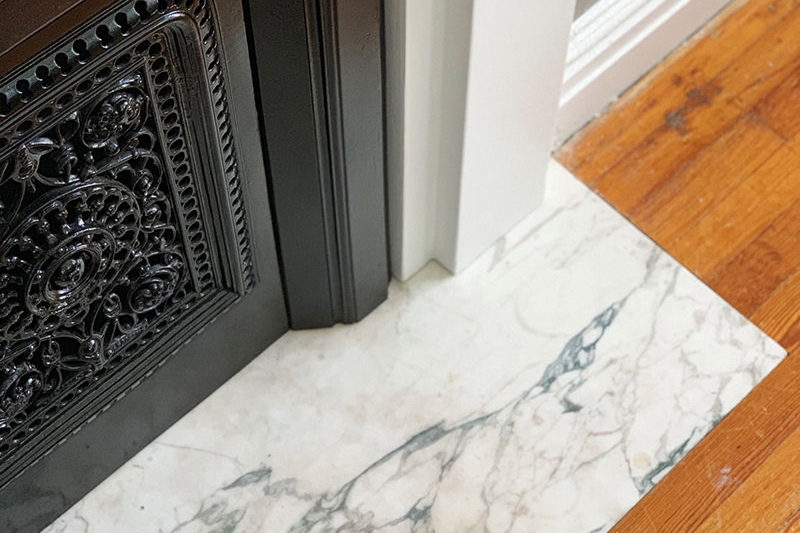
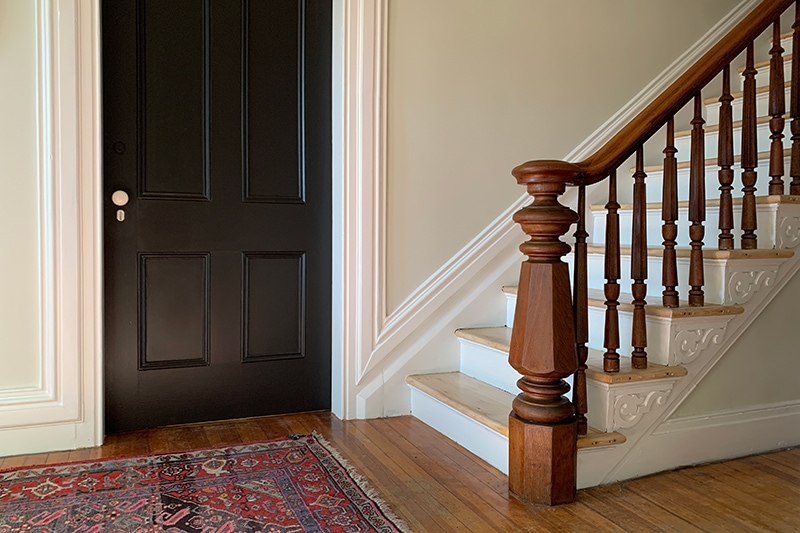
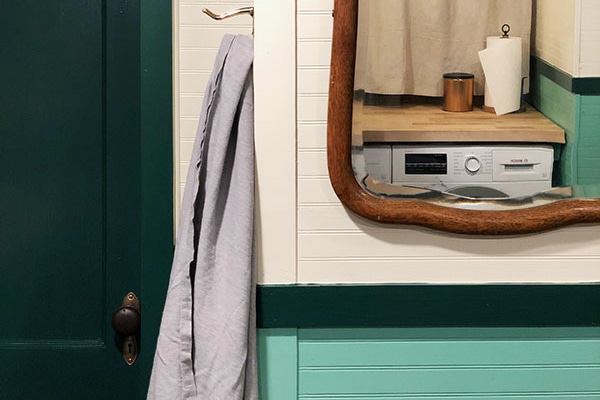
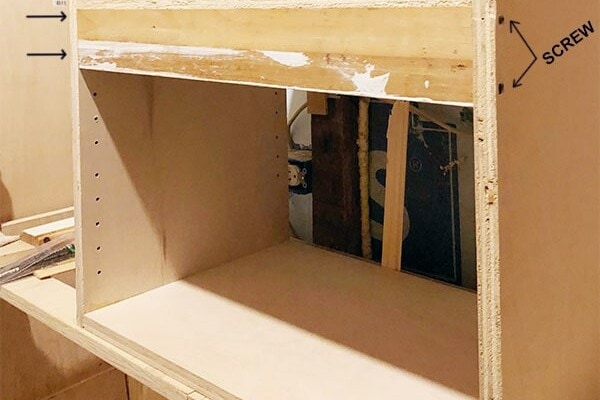
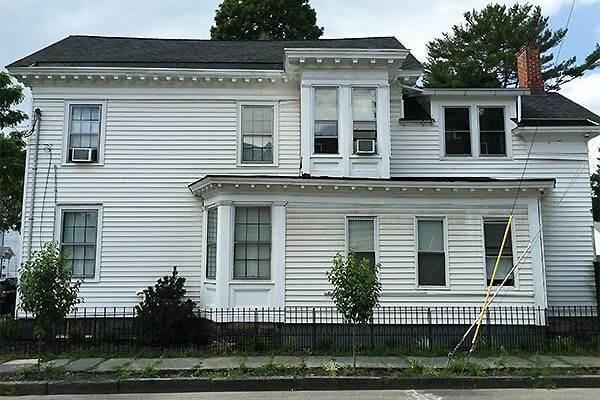
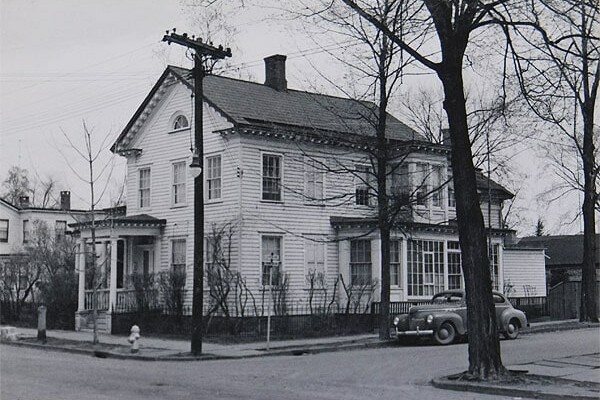

i was just about to go to sleep and this popped up.
you’re crazy Dan, i would not like to pass you in a darkened dark alley (if i were a shitty plaster ceiling that is) (otherwise i’d be psyched)
Your preemptive comment #1 was hilarious. I totally agree with you but also could see someone, or a lot of creative people, suggesting you paint these beams white. No.
Also, not that you care, but plaster veneer over drywall was used as the standard around Chicago for about 2 years in the early 1940’s. I just sold my place that was ALL plaster veneer, and I must say you kind of get the best of both worlds including really soundproof, solid, crack-free walls. Good call if you can afford it! But I also agree for a ceiling, there is nothing wrong with drywall.
That’s really interesting! Maybe we have plaster veneer. It would explain why the screws for the plaster buttons don’t seem to be catching any lath.
I do care! That’s really interesting. I actually thought that plaster veneer was a pretty new invention (like 1990s), so I’m intrigued!
My 1950 house has plaster veneer over some kind of crazy heavy concrete(?) wallboard. I really like the plaster veneer though, so pretty and so unlike drywall.
I am so glad you are blogging this authentically and not glossing over the backbreaking, boring, or frustrating details. HGTV and DIY make these demos look effortless, but in my experience, and yours, they can involve a lot of blood, sweat and tears (and mouse poop). I say keep up the good work on your house, apartment, and blog. Yours is one of my favorites.
agreed! it’s pretty unique. I’m kind of obsessed with you and your blog. whoops, sorry, is that creepy!?
Lord – that framing looks like something my husband would do. He has this compulsion to add at least 3 more nails/screws than are functionally necessary.
can I send you a couple of those tyvek suits? just the thought of raining mouse poop makes me want to scream…
…and I’ll send along some homemade shampoo!
“Everything is hard and it takes forever and there are no such things as happy surprises we’re not that terrific. The end.” This. Yes. 10 years in and ten thousand times yes. And I always, ALWAYS, forget it when starting a project.
Sadness and despair aside, I’m loving that wallpaper.
Rationally and practicly (?) it was a good idea to take the ceiling out. But I can imagine how you must feel after/ during all that. My guess: it was probably made by the person who made the wall in the entrance. It will be great and in a while things will look up, don’t despair. (And deep down in your heart you know you would do it all again, right?)
Have a wonderful weekend, Simone.
Oh dear! Big big hugs. But you know that ceiling had to come down. It was a highly sensible decision (let’s call it a carefully planned decision) so that you could get all of the dust(and mouse poop) out of the way at once and then re wire the electrics and do the new ceilings in both rooms at the same time. After all, now it is down, it’s no longer hanging over you, waiting for you to make that awful decision as to when to bring it down.
You know preparation is always the worst. Mother used to say ‘you have to suffer to be beautiful’ when she was plucking my eyebrows when I was young and found it a painful process. Just keep thinking how beautiful your house and home is going to be.
Susan
Electrical sucks because it isnt pretty and fun and takes all your money, but it is sooo worth it. My Dad recently updated his 1950s bungalow with a whole new breaker panel and outlets galore! It is amazing- you can run the dishwasher and kettle at the same time! You don’t have to use one specific plug to vacuum! Oh, and apparently all these years the microwave had been run with an extension cord he fed up from the basement!
But extra outlets is so amazing. older houses just werent equipped for the needs of today
Progress, it’s all progress. On a somewhat unrelated topic, as someone with renovation-induced asthma, I urge you to throw out those little paper masks and buy a real respirator (buy two if you really love Max). Alex at old Town Home recommends a good one. Even if you’re not dealing with asbestos, you shouldn’t be inhaling all that mouse poop and plaster dust and other crap. I’m now the crazy woman who wears a respirator for all my DIY projects, even painting, and it makes a huge difference. You don’t realize how much bad stuff you’re breathing in until you’re not breathing it in, anymore, if that makes sense…
Thanks, Laura! The masks we’re using are actually much nicer than the cheap little paper masks that I think you’re describing——I don’t have the package on me, but they’re made by 3M and rated for dust and debris (as opposed to just fumes or whatever”¦). We actually own much nicer respirators that are rated for asbestos, but honestly”¦they’re just too uncomfortable and cumbersome (and hot!) to be wearing for hours and hours of major demolition unless we really have to. I’m sure something more intense would be better, but I have to say that I think these masks do a pretty good job.
I know it seems like the heavier 3M dust & debris are doing a good job—and they are—but if you’re not wearing them at all times during the hours and hours of major demolition that you are doing, you defeat the purpose of ever wearing them. The accumulated residue and chronic exposure is what will irritate your lungs over time and may leave you with deeply inhaled substances that have long term health consequences that may take years to fully emerge. You should replace disposable respirators at least every 8 hours of work but more often—usually when they start to feel hot and uncomfortable and annoying to breathe through it’s a sign they are getting clogged with dust. I know they are cumbersome, but consistently using respirators can make it possible to enjoy your home when you are all done. The longer the project the more important it is to use the best barriers to irritants possible.
Y’all have been really lucky, working barefoot or wearing canvas hightops, in t-shirts, using bare hands rather than work gloves (although I think that’s probably dramatic license in your narrative style, late at night and alone. . .I’ve seen simple accidents become life-threatening episodes because folks had to resolve things by themselves and couldn’t get help/to help quickly and also unimaginable freak accidents that haunt me still. I keep my fingers crossed whenever I come to check in on what’s going on at your place.
I’d also recommend getting a good air cleaner for your bedroom—as you’ve mentioned, that demo dust goes everywhere and it’s nice to have at least one place where your respiratory system can take it easy and your body can use its own resources to clear whatever you’ve inhaled for the day(s) and get some respite from working quite so hard. Good brands like Austin Air can be found on craigslist.
congrats on moving forward!
I really do appreciate the concern and care that went into your comment, but please know that I actually do take safety pretty seriously. I’m not really sure where you’re getting some of this”¦we did wear our respirators throughout all of the demolition, from start to finish, only taking them off when we were either outside or a couple rooms away (both times, the rooms were blocked off and most of the dust was contained, although much of the house did have a light dusting when all was said and done). We did change our respirators every few hours, we most certainly did not do any of this (or really anything at all?) barefoot or with literal bare hands (I just meant without lots of tools”¦I was of course still wearing work gloves). I think I’m pretty good about dressing for the job at hand”¦not every renovation task requires work boots and full coverage (both of which I own and wear often). And though I haven’t mentioned it, we do have an air purifier.
I know your comment is well-meaning, but I just wanted to clear that up. I really do appreciate and respect the risks associated with doing this kind of work and I do the best I can to mitigate those risks for myself and my family.
Hi Daniel,
Thanks for your response to my concerns—you took it in the spirit I meant it. . .wanting to make sure you survive this with your health intact! I think I got the wrong idea from some of the pictures and the earlier story about your friend working barefoot and getting stabbed by a nail.
I worked for the hazardous compliance group when I was in art school (I’m a printmaker by training) and then as a house painter and am really sensitive about this issue. So maybe I over-reacted and jumped to conclusions. I’ve seen terrible accidents happen—they’re accidents because no one planned or expected them to happen—even when folks are doing all the right things and especially cumulative exposure to particulates through breathing and through skin/sweat contact, as those consequences can take years to emerge.
It’s hard to wear masks all the time but since you are, mentioning that could remind others to do so, too. I would love a post that talked about the safety stuff, especially that you have and use an air purifier, it’s something a lot of folks don’t know about. It sounds line you’re on top of things and it’s so rarely talked about.
That’s a good point, and I will definitely try to address it in future posts!
Yeah, my friend stepping on the nail…she was wearing flip-flops and I did offer repeatedly to give her a pair of real shoes, but she refused! Lesson learned, though…now I’m insistent on everyone wearing decent footwear, even if they don’t want to!
Keep on trucking!! I totally understand your impulse to get these things done at the expense of your sleep…I pulled a similar move last weekend. But remember to rest. It helps with everything, I swear.
Have you thought about drywalling the ceiling yourselves? My ex and I rented a jack and did our 9 ft. living room ceilings. It was totally do-able.
I’ve thought about it, but I’d really rather not if possible. Because our house is pre-industrial revolution, the joists aren’t all standard, so it’s going to take some careful leveling to get everything flat and even. I’ve never drywalled before, and I’m mostly just worried that trying to mud and tape on a ceiling for the first time is just going to be a recipe for disaster. Assuming it isn’t too expensive, it’s just one of the few things that I really think will be worth just paying somebody else to do!
Why did everyone install those drop ceilings anyway? Did they serve a purpose? Did they just like the way they looked (ha ha)? I remember them in my great, great grandparents farmhouse too.
They served a couple of purposes, actually! In this case, they were (at least in theory) an easy to way to cover up failing plaster (which would have been both unsightly and dangerous), but they also provided more sound insulation between the upstairs and the downstairs, which would have been helpful when the house was divided into two separate living units. Oftentimes ceilings were dropped in old houses from 9-10′ down to 8′ to help contain heat and lower heating costs. It’s also easy to forget that people really appreciating the features of old houses didn’t become all that popular until the 80s and 90s”¦I think in the 50s and 60s, most people really just wanted new houses with new features, and lowering ceilings with acoustic tiles was seen as a modernizing improvement. It’s crazy to think about now, but the culture surrounding housing and design was much different back then!
I’m really enjoying your posts about the restoration. I know it’s crazy for you guys to be going through, but it’s helping me understand the time, mess and cost of doing that sort of thing. I live in an 80+ year old farmhouse, which is not as old as your house and not NEARLY as big, but it needs a lot of work, and your posts are helping me form a realistic plan for getting it done. So, thank you! :)
Also, your house is so incredibly gorgeous. It’s a thrill to see more of its beauty and personality peek out with every step forward (and even backward!) that you take. It’s going to be truly amazing when you’re done!
Thank you, Amy!! I’m really glad to hear that you’re finding it useful!
This reminds me so much of my DIY condo renovation (except I only had 900 sq feet to contend with). So many, many times asking “why?????” in various tones of rage and despair. But when done, and painted, and furnished, (and after many gin and tonics for forgetfulness) it is so worth it.
The most painful part may be when friends and family and internet peeps who are not up to date with the level of effort see your home and say “You are so LUCKY! Why can’t I find something like this?” As if you just found the place. The painful part will be not killing them that is, or maybe stiffling your maniacal laughter and tears.
Ha! I kind of experience that ALREADY, even at this stage!! Taking down the weird 70s walls and renovating the kitchen already made the house SO different than it was when it was on the market. I guess I could get annoyed that other people didn’t see how great it could be, but it’s probably smarter for me to just be happy that they left it for me…
All that furring wasn’t just holding up the acoustic panels, it was keeping the plaster from falling on your head.
You didn’t mention it, but I hope your going to install sound insulation between the joists. You’re going to be losing a layer of material, if your doing just 1 layer of Sheetrock. You might want to use 5/8″ th. instead of 1/2″ for better acoustic separation. If you have the ability to lose 7/8″ of ceiling height, you could use a resilient channel from US Gypsum. It will further reduce noise transmission from above. It’s called an RC-1 channel. This products benefits from the weight of 2 layers of Sheetrock which could be 1/2″ th. Your installer would shim the RC-1 down from the joists to create a level plane.
Good luck.
Getting an old house, or any house that needs work really, back to a ‘blank slate’ is hard work.
I think you are being very smart; and very strong, to be willing to live IN the demo in order to get more for your $$ with not piece working the repairs/upgrades. Re the ceiling, will you also put in batt insulation up there between the floors? Hiring a drywaller is a very good investment. I got guy+helper to do it “on the side”, but he was a drywaller for a company by day. I literally saw some guys drywalling at the airport(!) and asked them if any of them did residential drywalling on the side like on a weekend, and gave them my phone number. A little scary, my hubs said they prob thought I was propositioning them! Like “drywalling” is “whatthekidscallitnowadays”. Seriously. Anyway. It all worked out. I guess I could have been murdered. But I wasn’t.
I personally think drywall is superior to plaster. Someone feel free to convince me otherwise, but after living in an old home with plaster that chips into a million pieces, I think it’s far easier to repair drywall and drywall doesn’t crumble like this. I feel that plaster dries out and cracks so easily, and shows blemishes badly.For a ceiling I would without a doubt use drywall too.
I have a plaster ceiling right now, that some unfortunate soul of the past sought the need to texture. There are giant cracks in the plaster from age. No pieces are falling like in your pics, but there are very long thin cracks, or cracks (perhaps settlement) that you can tell have been repaired for ages and always come back. I wish I knew how to fix them without gutting. I’m afraid plaster screws would crack it more, I’ve never used them and have no idea what’s under the ceiling for them to screw into. And even if I do fix the cracks, there’s no good way to patch it because of the texture. Argh!
look into the ‘plaster buttons’ thing for that crack… Daniel has linked to it in a post here I think.
Sometimes the gut is right in general but wrong on specifics. Happier surprises lie ahead. That’s what my gut says, anyway. Am 100% sure yours does, too, with that innate triumph of hope over experience. At this point can you even think ahead to what’s next after the new electrical and ceilings are done? Back to the front foyer, or something else?
I just have to say this—what about sconces? I don’t blame you on the single lighting fixture thing, but I’m sure you could find reproduction sconces that would work well in your home, and it’s just sooooo nice to not have all your light coming from overhead or a bunch of table lamps that need to have their cords concealed somehow. You know? I’m a hardcore sconce advocate now (and you seem handy enough that if you just go out of your way to get easy junction boxes with fixtures that cover them, you can swap them out or drywall/psuedo-plaster over them someday if you decide the sconce lady was crazy).
I don’t know”¦we might do sconces elsewhere, but not for this space”¦there’s just nowhere really great to put them. I generally find that an overhead light on a dimmer switch combined with some lamp options makes things pretty pleasant!
We save a ton by getting the drywall in bulk and putting it up ourselves. You seem about as handy as we are, and I promise it is not hard. Then we just hire guys to come do the taping and mudding. Granted, with ceilings you’ll have to rent a drywall scissor lift, but it might be worth looking into? $1200 for two ceilings seems insane, but that might just be the difference in pricing between NY and ID. It was only around $1500 for a crew to mud and tape our entire 1800 square foot basement (walls and ceilings) after we hung the drywall ourselves.
Oh ha. Sorry, should have read the comments first. I see someone already asked.
Yeah, I’ve thought about doing it that way, too, but I’m worried about shimming out the joists properly first. I suppose that’s probably within the realm of my capabilities, but then there’s transporting the drywall and renting and transporting the lift (I drive a Jetta”¦dumbest car for my life!), getting max to help me”¦it just ends up feeling not worth the amount of money we’re actually likely to save. But thank you! I think under more normal circumstances, it’s a great option.
Not to beat the very dead horse, but we had the drywall and the scissor lift delivered.
No, that’s good to know, thank you! Logistics aside, it’s the skill level required with this that I’m worried about, but I have no doubt that we’ll end up doing drywall in other places down the line. We’ll probably take advantage of delivery if we can, too”¦I didn’t even think about that as an option. Thanks!
Wow, I’m reasonably certain that I live in the same headspace as you. ALL of my “projects” so far have included a sizable break right in the terrible middle while I have a minor (major) emotional breakdown/panic attack at the realization that something is not *quite* right. All of them. And my house is only 10 years old, so I don’t really have to worry about anything like asbestos, or lead paint here, or, you know, preserving the artistic and historical integrity of the house. On the other hand, I’m not likely to rip up a nasty linoleum floor and find an ancient heart-of-pine floor just begging to see the sunlight again.
And I have, like, at least a billion projects half-started. Working on painting and taking down fixtures in the master bath? Why finish THAT when you can, I don’t know, knock down a wall in a hallway (we thought there was water damage … and there was), and then leave the shattered bits of drywall there for at *least* a week while you think about the logistics of getting enough drywall boards home in the snow to be able to finish the demo and put up new boards. Oh, wait, the truck’s in the shop because it magnetically attracts other cars? Gosh, I sure hope we’re not leaking warm air into our crawlspace through that massive hole (we are). My husband is a tolerant man, and we hardly ever go down that hallway. I think that helps. Also, wine. Wine helps.
So with the electrical wires behind the old plaster, it seems that this ceiling was not the first one and installing electrical wiring therefore represented a point of major renovation in the house’s history. Can you discern at this point any further outlines from the original structure prior to the installation of the removed ceilings. I am so curious as to why the interior woodwork arc is placed so close to the top of the ceiling you just took out.
I’m pretty certain these ceilings were original, actually”¦plenty of houses were wired (and continue to be wired!) long after they were built without significant renovations”¦a decent electrician can run wires through finished walls without causing significant damage, and that damage isn’t generally too difficult to repair.
The best explanation I have for the arch is that it’s just a weird quirk, honestly! The vertical pieces on either side extend to the same height as the top of the door casings, and the arch height would have been reliant on that and the width of the opening. I think that’s just how it was built!
Indeed! Our house was completely electrified at least 10 years after it was built without any discernible damage to the original plaster walls or ceilings. We ran a LOT of new electrics when we bought the house, too, again without any damage. We were working with a very skilled electrician, luckily, and of course it’s easier to just drop a ceiling instead, but it’s definitely not impossible. :)
(There was loads of damage from water over the years, of course, but that’s a whole ‘nother thing…)
Interesting. The attic of my place still has some unremoved ceramic knob and tube wiring along the walls, which were never nogged. At your house, perhaps gas lighting utilities led to a more modern initial wiring exposed by the recent ceiling removal.
When you’re done with the renovation (if one is ever done with a project like yours) you should write a novel from the perspective of the house (as a living thing with it’s own voice) about about the comings and goings of people and events that lived in it through the years. I bet it would have a lot to say.
This is a GREAT idea! You’re such a great writer that it would be a best seller (at least I’D buy it!)
I saw a “book” for a custom-built house once, which had photos of every wall before drywall was installed – a super-useful reference for all later owners who might be wondering “what’s behind this wall?” So, you may want to photograph/document the ceilings once you have electrical done, but before the drywall.
Yes, I definitely plan to do that with these ceilings! Taking out the ceilings also means that we can the very tops of a lot of the vertical studs inside the walls, so I want to map out those before they’re all covered. I may never reference it, but finding a stud with plaster and lath walls can be very difficult.
I am a designer at a residential architecture firm and we recommend to our clients who are doing major renovations in old homes to spring for a plaster ceiling with drywall walls. The texture is much more apparent on the horizontal surfaces than vertical. Spring for the veneer!
Oh, jeeez. Hmmmmmmm. I’d like to! It’s just a $$ thing”¦I’m not made of it!
Are all lower wall outlets in the baseboard, horizontally oriented, as shown in one of the pics above? That’s so much better than outlets pock-marking the walls!
Many of them are, yes! A few have been added to the walls throughout the years, but the majority of our outlets are in the baseboards. Unfortunately I *think* it’s against current electrical code to have them this low, but I think we’re allowed to keep them since they’re already here. New outlets will be the standard 12″ from the floor. I agree, though—it’s much better looking!
“I *think* it’s against current electrical code to have them this low, but I think we’re allowed to keep them since they’re already here.”
Right on both counts, with is both fortunate and unfortunate. I LOVE our baseboard outlets…
I love the crucifix moment! :) I think it’s a sign that your suffering will… ahem… bring salvation? ? ? I don’t know, I’m not into Jesus really…
On the positive side (because I too tend toward the Pollyanna/delusional), you are learning SO MUCH about renovation and DIY that you didn’t have the opportunity to learn before! I too am learning through reading your blog that I will 1) probably never attempt anything like this and 2) it’s much more fun to live vicariously through you.
Whoa, mouse poop. It’s been my unfortunate experience that dropped ceilings and tin ceilings (perhaps all ceilings!) contain mouse poop. VERY IMPORTANT TIP: While you have the ceiling open like that, go around the perimeter that would normally be covered and BLOCK ANY HOLES YOU SEE. Or don’t see. BLOCK EVERYTHING. Then when you have a ceiling again, no way will any mice be coming in there. Even if you think you don’t have mice.
Use fine wire mesh you buy in a roll. You can fill it in with cement or plaster, also, if you desire.
Man, I love your writing!!
Is that one radiator in the corner?? I have never seen a radiator like that before.
Yes, it’s a corner radiator! Me neither! I guard it with my life. :)
I have been following your blog sense you bought your house. It reminds me so much of the work my husband and I have been doing (for the past 6 years) on our 1907 house in Portland Oregon. I laugh at your pictures and also sometimes want to cry thinking about all the dust, 3 drop boxes full of demo garbage, and the sometimes breakdowns thinking that it will never end! Now I look back on those pictures and can’t believe that we lived through it and didn’t kill each other. You never realize how hardy you are until you have lived through and lived in a remodel of an older home. It is very much a love/hate relationship.
As I was doing my own, much smaller, demo project the other night, I had fairly irritated discussion with the dog about why things have to be both disgusting and weird. Why can’t they be just one or the other? I mean, mouse poop and hundreds of furring strips and nails. Why does it have to be both? That’s just reno overkill.
Love your house!
A quick note on plaster veneer. This process is arguably less labor intensive because there will only be one coat of plaster to apply and to dry rather than the three coats of drywall compound, plus skim coats. Each of these coats will take nearly a full day to dry, plus sanding time after. Anyway, my point is that drywall is very labor intensive, so, plaster veneer may be the less expensive choice in the long run.
If you do decide to go the drywall route, a good professional job is so, so, so worth it (emphasis on good). They will be able to give you the best final finish, which is really hard to achieve when dealing with old framing. I helped my dad (who was a general contractor back in the day) drywall a small studio two years ago. While the results were pretty good, we both agreed that it would have been worth hiring out.
Good luck! Can’t wait to see what you decide on, as well as the final result!
Medallion sizing tip: I use the same trick as I do when estimating the size that a chandelier/pendant should be. Measure the length and width of your room in feet, and add them together to get the diameter in inches. For example, an 8′ x 10′ room = 8 + 10 = 18″ diameter. A 24″ diameter medallion works great in my 12′ x 12′ dining room.
Another trick favored by the internet is to multiply the room dimensions and divide by 7. In this example, 12′ x 12′ = 144 / 7 = 20.5″. When in doubt, round up. Slightly too big is better and full of less painful regretsies than too small and dinky, espesh if you have the ceiling height.
I think the mantra of the previous owners of your house was “Under Plan and Over Build.” Both of those ceilings were completely bonkers, so BRAVO for tackling the second one after the tragedies of the first. I love following along on your progress, YES it is progress, even when it feels like a tragic mess. Keep your chin up and make a new mantra for that gorgeous home!
OMG, I so feel your pain. Sometimes, you plop down at the end of the day physically, mentally, and emotionally worn out. THe excitement, worry, thrill, despair all crash down at once, ya know? We bought The Domus (all good houses should have names) 4.5 years ago and just now is it getting into shape. Like you, we didn’t have boatloads of money (I wish) and had to compromise because of that. My rule is that if it’s a permanent item or an item designed to last 10-100 years, spend the money. If it’s something that will work “for now” and can be easily changed (faucets, paint, even countertops) then go budget in those areas. For example, when doing the bathrooms (we built two baths from scratch) I picked marble tile and sinks that I loved. Those aren’t things that are easily swapped out and are expensive anyways.
Do your homework on drywallers. We had a real ass do ours and I’m still fixing his mess.
I found that I needed to assume the worst, hope for the best, and brace myself. That way, I was always surprised that things were better than I expected.
We had the blueboard/plaster thing done on two of our ceilings, and it wasn’t a whole lot more expensive than what you were quoted, so you should definitely look into it. It was about $800-$1000 per room (in Boston).
If you have any plumbing above (doesn’t seem like it in this room) now’s a good time to redo that too. We couldn’t afford to redo our washroom but had shoddy plumbing redone to the fixtures from below prior to closing up the ceilings.
They may want to drop your ceilings slightly with metal channel. We’re having issues with ours (now 6 months later) – some seaming and cracking. Not sure if it’s because they suspended from the joists or if they just didn’t use enough screws or what, but going with the plaster veneer might avoid this and give you a nicer finish. I find priming fresh drywall a pain, but you seem more patient and DIY-wise than me!
Mouse poop deluge flashback! When I took down the accoustic tile ceiling in my basement it rained so much mousepoop the floor was brown. It filled almost an entire trash bag. Also discovered that the side of the house had apparently been covered in ivy at some point, which had happily grown in through the area where walls and foundation join and into that ceiling space”¦probably bringing all the dear little meeces with it”¦.So had to tear down the ivy inside too!
Old house reno. is such a never-ending source of amazing stories.
Reading your posts, I feel a lot less lonely knowing someone else is going through the same things as I am! Thanks Daniel your blog truly lifts the spirits!
Hi Daniel!
I’m from Germany and i wanted to say “Respect for you guys to do all this work to save this house!” We live in a house from 1906 and have been renovating for 3 years and there’s still something you could do. In old houses you’ll never be done but that’s ok i think.
I always wonder how our house looked like when it was all brand new… it must have been soo beautiful.
Keep going!
Julia
God be with you, and of course you are not alone in your temporary (I promise) despair, with your ceilings from hell. I of course, bought a very large house that had acoustic ceilings. I thought, hey a spray bottle, a scraper and a lot of back breaking work would do the job. But that would have been too easy. Instead it was a popcorn ceiling made out of plaster.. then we had a leak and my husband fell through the ceiling trying to fix the leak…shitty ceilings can literally zap all the inspiration out of even the best imaginations. Your blog is a delight, you are a delight. It will get better, just keep going. Someday you will look back and maybe not laugh but it will be a faint awful memory. Keep your head up, cause so far it is looking really great…..
I feel so bad that you have to keep tearing down the ceilings. Not so much because of the ceilings, but because you’ve not gotten to experience the joys of skim coating. ;-)
All in due time.
Good call on replacing the BX. We had that in our house and it seemed like every time I touched it the fabric wire was breaking in a new place. Glad it’s all gone.
Oh, don’t worry, I am skim coating! Just not ceilings”¦yet. :)
Daniel – just read this on Gawker and immediately thought of you (and then that guy from apartment Therapy-but since I find him a bit tiresome I offer you this PSA)
http://gawker.com/psa-dont-renovate-your-rental-apartment-1505874177?utm_campaign=socialflow_gawker_twitter&utm_source=gawker_twitter&utm_medium=socialflow
Yeah, yeah. OK.
I don’t know if the author of that “critique” lives in NYC or not, but I’m going to go ahead and guess he doesn’t. New York City is not a place where most people can even dream of buying property, and has an incredibly expensive and incredibly competitive rental market, meaning that the pressure for landlords to maintain or update their properties is extremely low. Using myself as an example, I rented this apartment at the top of my budget because the apartment had the *potential* to be nice with some improvements and I wanted to live in the neighborhood (where the market rent for a 1 bedroom is, currently, I think about $900 more per month than what we’re paying). That being the case, it was INCREDIBLY worth it for me to “renovate” my apartment (I hesitate to call it that, since all of the permanent changes that I’ve made, paint included, probably add up to less than $2K, spread out over two years, but anyway)——not because I expect to see a return on those costs (that’s just idiotic) but because it allowed me to happily live in a place that I wanted to live, in a neighborhood that I couldn’t afford to live in otherwise. That’s going to be different for everyone, and it’s not my place (or, frankly, yours or the author of the gawker article) to pass judgment about that. If the people featured in the New York Times article did the math and figured it was worth it for them to spend $45,000 on renovations to live in a great neighborhood in a good apartment at a low rent for 5 years while they raise their kid and afford to live in a better school district than they might otherwise, I don’t doubt that or begrudge them their decision.
What it really comes down to is the idea that every dime we spend on our living space should have the potential for return, which I think is generally a flawed way of thinking, and unproductive when you live (and, almost by definition, rent) in a place like New York. The majority of people who live here will NEVER own the place they live, and that doesn’t mean they should be barred from making their homes functional, safe, and comfortable, even if it doesn’t ultimately benefit them financially.
I just found your site and man do I love your writing style!
I’m in exactly the same process of ceiling renewal in our kitchen. The previous owner had put up some kind of wooden shelves as a ceiling, so we removed that one to have a look at the ceiling underneath as well. In our case we didn’t find any mouse poop though, but we did find an old beehive! Guess how much my wife got scared when she first saw it (she was taking down the shelves). The ceiling also wasn’t salvageable so we also went through removing all the old lath & plaster with all the dust as a consequence (I hear you there buddy). Next up now is insulation between the beams, as it’s a roof above it, and then a new ceiling in drywall as well. Good luck with that one!
Thanks, Koen! Welcome! And good luck with everything! All that dust”¦shudder”¦
Hi Daniel, are you guys doing anything to insulate/soundproof the ceilings? I have friends who are renting an old house in SF that was nicely renovated, but it seems like the renovation did not include any kind of sound proofing. Even if someone is walking normally upstairs it sounds like they’re jumping from downstairs. It’s like the sound amplifies. Is this a concern at your place?
I’m actually still thinking about that and trying to do some research, Jen! My understanding is that soundproofing between floors should definitely be done in rentals for exactly the reason your friend is now experiencing, but I’m a little bit concerned about putting insulation between floors——it seems like you’re not supposed to do that in houses because you actually want the heat to rise throughout the house, both to help heat the second floor in the winter and to let the heat escape during the summer (which, with no A/C system, I DEFINITELY do not want to do anything that would make the house hotter in the summer”¦). So I’m not sure! I’ll definitely discuss it if I do decide to, though!
On this topic I’d like to throw out some personal observations. That is, a minimalist interior design really enhances any noise problems and an apartment with lots of “stuff” (including heavy drapes, furniture, layered rugs, tons of bookshelves, etc) truly dampens lots of noise and in particular, street noise. I am not sure about direct overhead footfalls as there could be wood floor creaking and structural vibration. I imagine rubber backed flooring would easily help that aspect but take away from venting properties, but how those balance out in a given room I couldn’t say. What I have observed in some multi-floored budget chain motels in busy, noisy locations the rooms are totally and remarkably sound dampened, so there is structural technology out there and not necessarily just in a luxury market.
daniel- i’m so so proud of all of the work you’ve done to the house and your apartment. your taste is flawless (#teamnoexposedbeams) and it’s such a joy reading your posts. i laugh out loud at least fifty times during each one. quick question- i’ve noticed a few thin, white vertical pipes running throughout the house (mostly near windows, like the one in the bottom right of the last picture in this post). do you know what those are? what purpose do they serve? just curious. keep up your flawless-ness. xx
Aw, thank you Lindsay! The pipes are heating pipes for our radiators! The house was originally heated with wood stoves, and the radiators were put in probably around 1900, so the majority of the radiator plumbing is exposed. In historic restorations people will often have the pipes re-routed and buried in the walls, but that would be super expensive. They don’t really bother me, though—I think once they’re painted to match the walls, they won’t be so noticeable.
Matt DiFrancesco is a local general contractor who can do all kinds of renovations including ceilings, he’s really good. 347-432-2764
Thanks! I’ll call him up!
My husband sent me the link to this post after reading just the first paragraph with a “misery loves company” message. Not that I wish you any bad house karma, but it’s nice to know it’s not just “us” – keep up the hard work! It theoretically will be done someday… (This is what I continue to tell myself…)